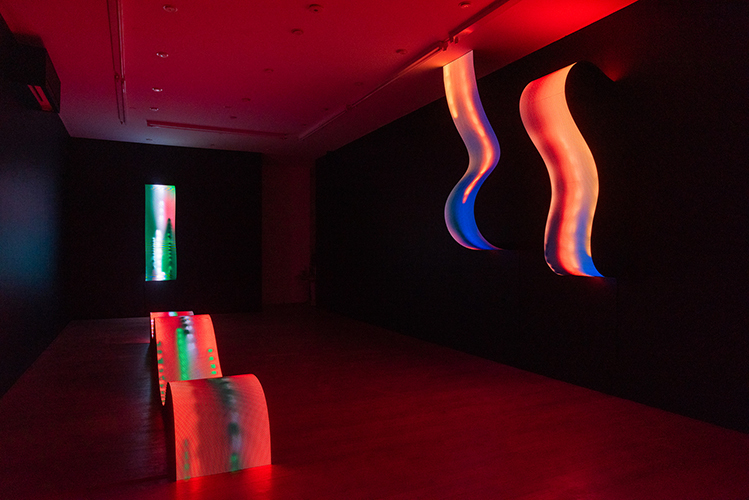[ad_1]
After three months with the internet as my primary portal to the outside world, I was intrigued by the premise of Daniel Canogar’s latest work: “to expose the hidden threads of data networks.” Inside bitforms gallery, six large, wavelike metal structures covered with modular flexible LED screens hang on the walls or sit on the floor, all part of the artist’s “Billow” series (2020). Streaks of neon green, red, blue, pink, and yellow light creep down the screens, the product of a data visualization program that Canogar created. Each animated color represents a Google search trend in real-time: as the word or phrase grows more popular, the color warms in tone. The bands of color appear to move across the sculptural screen constructions in succession, from the front of the gallery to the back. This creates the sense that these sculptures form one continuous unit passing in and out of the walls and floor.
Courtesy bitforms gallery. Photo: Emile Askey
The installation brings to mind the fiber optic cables on which the internet’s endless flows of data travel underground and on the ocean floor. Canogar’s work, however, renders the data on the screens without much context; we have no sense of what search terms the colors represent or how they relate to each other in scale or frequency. Occasionally, near-illegible words drift through the chromatic stream, denoting particularly popular search terms. I managed to make out a few blurry letters before they ran off the curved screens.
When mostly awash in a bright color, the screens resemble the kind of corporate sculpture found in large hotels and convention centers. But when multiple colors run down the screens in darker tones, throbbing and pulsing as they move over the bends, the sculptures become evocative of living organisms. Occasionally, a dark patch will join the blurred-out words floating through this colorful stream, like a bad thought passing through the internet’s psyche. The installation periodically turns completely dark, as if resetting itself, and the once-colorful sculptures transform into black shapes recalling curved sheets of graphite. As the data streams back in, it creeps from one screen to the next as a thin drop of color, followed by others until the screens are full again.
Courtesy bitforms gallery. Photo: Emile Askey
Over the past decade, Canogar has made a number of sculptural series employing flexible LED screens. Some earlier versions had their wiring exposed at the back, resembling something you might find described in a William Gibson novel. This cyberpunk aesthetic is also evident in series like “Small Data” (2014), which feature overhead projections onto tangles of wires and broken computer parts, creating a formal interplay between the messy materiality of the electronics and the projected light. The “Billow” works are more polished, which places greater emphasis on the content conveyed: at times, they seem less like sculptures than sleekly designed information displays. The sculptures are technically impressive, at times even mesmerizing. But abstracting Google search trends draws attention to the flow of information without revealing anything about it. Rather than demystify the powerful tech company’s machinery, the sculptures transform its data into indecipherable visuals. In doing so, they risk becoming merely a pleasing simulacrum for digital information and yet another screen to distract ourselves with.
[ad_2]
Source link


